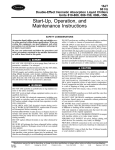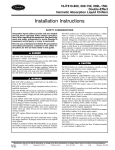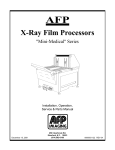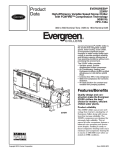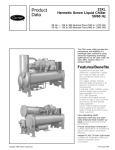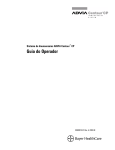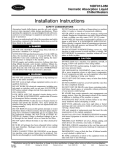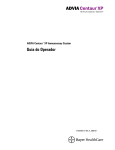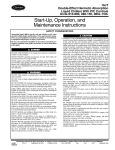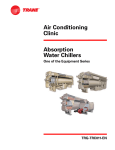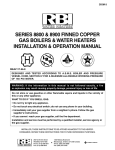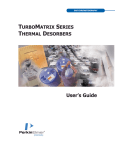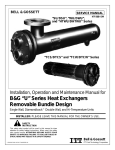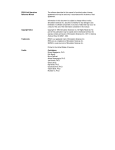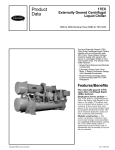Download Carrier 16JB Product data
Transcript
Product Data 16JB Steam/Hot Water Single Effect, Hermetic Absorption Liquid Chiller with Product Integrated Controls (PIC) 50/60 Hz 108 to 680 Nominal Tons (380 to 2392 kW) Carrier’s 16JB single effect hermetic absorption liquid chiller offers a viable alternative to traditional electric driven chillers. By utilizing low pressure steam or hot water, the 16JB avoids high cost electricity and qualifies for utility rebates and incentives as a gas cooling product. The utilization of low pressure steam or hot water in the generator provides the 16JB with application flexibility. • no CFCs; environmentally friendly • one-stage design for simple, reliable operation • operates using low pressure steam or hot water • quiet, vibration-free operation • few moving parts equates to high reliability • Direct Digital Controls (DDC) for optimum chiller performance. Features/Benefits Single effect absorption provides efficient, economical water chilling with minimal use of electricity. Cost-effective cooling Alternative-energy chiller — The 16JB offers an alternative for building owners who want to avoid the high operating costs associated with electricdriven chillers. Powered by low pressure steam or hot water, the Carrier 16JB single effect absorption chiller not only reduces or eliminates electric demand and/or ratchet charges, but also allows the owner to take advantage of gas cooling rebates and incentive programs offered by many utility companies. Copyright 1998 Carrier Corporation Form 16JB-2PD Single, reliable operation — The 16JB absorption chiller employs a single generator to provide one stage of solution reconcentration, making it the most basic of the cycles available today. Simplicity of design, combined with its numerous other quality features, equates to inherently high reliability. Few moving parts and simple, dependable operation reduce downtime, as well as service and maintenance costs. The 16JB chiller offers typical full-load steam rates of approximately 18 lb/hr-ton at standard ARI (Air Conditioning and Refrigeration Institute) operating conditions. Superior part-load performance — The 16JB’s standard concentration control system allows stable, partload operation at cooling water temperatures as low as 55 F (12.8 C) without the need for a cooling tower bypass. In addition, a control valve ensures stable, continuous evaporator pump operation at part-load conditions. The 16JB has a continuous operating range from 100% to10% of machine capacity. Application versatility Designed to suit a variety of applications — The use of steam or hot water from a number of sources allows the 16JB machine to meet a variety of cooling needs. Waste heat sources generated from industrial processes and cogeneration systems can be utilized to provide chilled water for process cooling as well as comfort cooling, reducing the need for purchased energy and contributing to even greater energy savings. Ideal for new or retrofit applications — Whether intended for replacement of existing chiller systems or for new construction purposes, the 16JB is well suited to meet the needs of almost any cooling application. The 16JB’s 15 model sizes, spanning a capacity range of 108 to 680 tons, make the 16JB single effect absorption chiller the ideal choice for comfort cooling and/or light industrial applications. Carrier’s computerized performance ratings assist in the selection of the appropriate machine, properly sized to meet exact job requirements. Dependable operation, as well as low sound and vibration levels, ensures occupant comfort, even when installed on upper floors. 2 Combine absorption and electric-driven chillers — Utilizing both absorption and electric chillers in a central plant offers the flexibility to base load one chiller, while using the other to handle peak load requirements. Hybrid chiller systems have proven to be an economical solution for many comfort cooling installations. In many geographical areas, operating the electric chiller as the base loaded machine, while utilizing the absorption chiller during peak load conditions, avoids or reduces electric demand charges. Depending on utility rate structures, a 16JB single effect absorption chiller used in conjunction with an electric-driven chiller may be the most efficient and cost-effective combination available. Location and installation savings Ease of installation — All 16JB’s are completely fabricated, assembled, and wired in the factory as single piece units. Standard shipping configuration is either 1- or 2-piece(s), depending on size. Refer to the 16JB Standard Shipping Configuration table below. 16JB STANDARD SHIPPING CONFIGURATION SIZE 010-047 054-068 1-PIECE X 2-PIECES X Model sizes through 16JB047 ship completely assembled as standard with an option for 2-piece shipment. The 2-piece shipment is ideal for retrofit or replacement installations where access into the equipment room may be limited. The 16JB054-068 machines ship in 2 pieces as standard for easier handling and rigging. Jobsite re-assembly and alignment of units shipped in 2 sections is simplified by pre-erecting the machine in the factory and incorporating weld-type assembly flanges on all interconnecting piping. Table of contents Page Features/Benefits . . . . . . . . . . . . . . . . . . . . . . . . . . . . . . . . . . . . . . . . . . . . . . . . . 1-7 Model Number Nomenclature . . . . . . . . . . . . . . . . . . . . . . . . . . . . . . . . . . . . . . . . 2 Options and Accessories . . . . . . . . . . . . . . . . . . . . . . . . . . . . . . . . . . . . . . . . . . . . 8 Machine Components . . . . . . . . . . . . . . . . . . . . . . . . . . . . . . . . . . . . . . . . . . . . 9,10 Physical Data . . . . . . . . . . . . . . . . . . . . . . . . . . . . . . . . . . . . . . . . . . . . . . . . . . . 11,12 Dimensions . . . . . . . . . . . . . . . . . . . . . . . . . . . . . . . . . . . . . . . . . . . . . . . . . . . . . . 13 Performance Data . . . . . . . . . . . . . . . . . . . . . . . . . . . . . . . . . . . . . . . . . . . . . . . . 14 Application Data . . . . . . . . . . . . . . . . . . . . . . . . . . . . . . . . . . . . . . . . . . . . . . . . . 15,16 Electrical Data . . . . . . . . . . . . . . . . . . . . . . . . . . . . . . . . . . . . . . . . . . . . . . . . . . 17,18 Controls . . . . . . . . . . . . . . . . . . . . . . . . . . . . . . . . . . . . . . . . . . . . . . . . . . . . . . . . 19-21 Typical Piping and Wiring . . . . . . . . . . . . . . . . . . . . . . . . . . . . . . . . . . . . . . . . . . 22 Guide Specifications . . . . . . . . . . . . . . . . . . . . . . . . . . . . . . . . . . . . . . . . . . . . . 23-28 Model number nomenclature Features/Benefits (cont) Microprocessor control features/benefits Direct Digital Product Integrated Control (PIC) — Carrier’s PIC provides unmatched flexibility and functionality. Each unit integrates directly with Carrier’s Comfort Network (CCN), providing a system solution to controls applications. PICs are pre-programmed to meet precise control requirements. PID (Proportional/Integral/ Derivative) control algorithms — PID algorithms provide tight chilled water control to optimize chiller operation. Local Interface Device (LID) — The LID, which can be configured to display in English or Metric units, provides unparalleled ease of operation. A 16-line by 40-character backlit, liquid crystal display (LCD) features 4 menu-specific softkeys. A default display offers a one-glance review of key chiller operation data, simplifying the interaction between machine and user. Chilled water reset — Reset can be accomplished manually or automatically from the building management system. Chilled water reset saves energy when warmer chilled water can be used. Steam demand limit — During start-up, the steam demand limit provides boiler protection (low feedwater, steam starvation) by limiting control valve travel during the initial warm-up period. Ramp loading — Ramp loading ensures a smooth pulldown of water loop temperature and prevents a rapid increase in steam consumption. Advanced crystallization protection — Protects against crystallization by automatically sensing impending abnormalities in the absorption operating cycle and taking a series of actions to either self-correct and/or limit the chiller from approaching the cycle crystallization line. Absorption cycle state points — Absorption cycle state points provide the operator with precise and dynamic cycle operating conditions at any time during chiller operation. They save time by eliminating the cumbersome task of taking solution samples and calculating state points and assist in both chiller operation and diagnostics. Refrigerant low temperature override — The capacity control valve position is inhibited to prevent freeze-up and ensure continuous chiller operation. Extensive service menu — Unauthorized access to the service menu can be password-protected. Builtin, enhanced, diagnostic capabilities assist in troubleshooting and recommend proper corrective action for pre-set alarms, resulting in more up time. Alarm history — The last 25 alarms and/or alerts are retained in memory with date and time stamps. Alarm histories reduce troubleshooting time and cost. Additional controls features/ benefits • Encapsulated circuit boards — Designed and built by Carrier, encapsulated circuit boards offer superior reliability compared to open board designs. • PROM (programmable read-only memory) based modules — PROM modules provide protection during power failures and eliminate time-consuming reconfiguration. They require no battery back-up. • Modular pull-out/plug-in design — This feature reduces field wiring requirements and simplifies installation. • Low voltage (24 v) design — Low voltage provides ultimate assurance of personal safety and control integrity. Reliable operation 16JB PIC control system features automatic monitoring and precise control of chiller operation — Each Carrier 16JB single-effect chiller includes a pre-programmed, factory-mounted and factory-wired PIC panel which is functionally tested prior to shipment. Chiller monitoring and control is automatic and continuous, and the LID on the front panel displays chiller operational status and fault indications in English or metric units. The PIC panel components include a Local Interface Device (LID), processor module (ComfortWorks™ controller), two slave processor modules (PSIO), a fused disconnect switch, pump contactors, ambient-compensated 3-phase pump overloads, multi-tap control power transformers, terminal blocks, relays, and all other necessary safeties and controls for proper chiller operation. Single point electrical connection — Installation costs are further reduced by eliminating field wiring between machine components. All unitmounted electrical items are factory-wired to the chiller control center and require only a single point electrical connection to the machine from the building’s electrical service. A multi-tap transformer mounted in the chiller panel provides secondary single-phase power for the 16JB controls. Low sound and vibration levels allow location flexibility — Low sound and vibration levels are characteristic of absorption chillers, primarily due to the fact that the only rotating parts are the refrigerant and solution pumps. The overall sound level of a Carrier 16JB is typically 80 dbA. This allows the machine to be installed near occupied spaces or in areas with strict sound requirements. Low vibration levels also make it possible to install the chiller on upper flows without special consideration for vibration dampening systems. Low maintenance Standard features simplify maintenance procedures — Every 16JB is provided with numerous standard design features that provide for convenient and simple maintenance. Removable waterbox covers on the evaporator, absorber, and condenser facilitate tube and waterbox inspection from either end. All moving parts are easily accessible for inspection or replacement, as required. The U-bend tube design in the generator greatly reduces the likelihood of expensive and time-consuming tube bundle replacement. Unlike ordinary tubes, the U-bend configuration allows the entire tube bundle to expand or contract as a unit when subjected to rapid temperature changes. The tube bundle floats and adjusts freely as a unit, decreasing tube wear due to thermal stresses and reducing tube bundle failures. Each shell is divided by a ‘‘U-baffle’’ forming a double sump. The U-baffle design not only forms a thermal barrier between the sections but also allows the solution or refrigerant to be stored temporarily on one side of the vessel while the other side is being serviced, consequently reducing maintenance costs. 3 Features/Benefits (cont) Factory-trained service organization — Carrier’s extensive service organization offers trained and experienced service technicians in every major city. In addition to routine maintenance and repair services, Carrier also offers a wide array of preventative maintenance, full maintenance, and/or extended service contracts which can be custom-tailored to fulfill any service requirements. Leakproof hermetic pumps cut maintenance costs — Carrier’s proven solution and refrigerant pump/ motors are leakproof, completely self-contained, and hermetically sealed. The hermetic design eliminates the need for a separate, complicated, and possibly leakprone seal water system and auxiliary water piping, while providing leak tightness and longer machine life. There are no packing glands or seals to maintain — air cannot leak in, fluids cannot leak out. Specially designed bearings absorb both radial and axial thrusts to ensure correct fit at all times. There is no possibility of external contamination since the fluid being pumped lubricates and cools the pump and motor assemblies. In addition, both the rotor and stator are separated by a stainless steel liner that protects the windings from the fluid being pumped. As an additional safety feature, thermal overload switches are embedded in the stator to protect against high winding temperature. The pumps are field serviceable and inspection is recommended after 6 years of operation. Pump isolation valves are not included on 16JB machines to minimize potential leak paths into the machine. The pump isolation valves are not required because of the exceptionally high reliability of the pump/motor assemblies. Superior corrosion protection — Absorption chillers must be protected from the internal corrosion that is always present when lithium bromide solution is in contact with internal machine surfaces. The Carrier 16JB absorption chiller incorporates a highly effective corrosion inhibitor to provide an extra margin of 4 protection against internal corrosion. Other inhibitors may necessitate the use of exotic tube materials in certain heat exchangers since they are less effective and require frequent maintenance and analysis. The superior corrosion protection of the inhibitor allows for the use of standard copper tubes throughout the machine (except for the generator [90/10 cupro-nickel]). This results in long machine life and dependable operation. Rugged machine construction — Every Carrier 16JB offers numerous standard features designed to provide reliable, trouble-free operation. The machine is fabricated to meet stringent manufacturing and design requirements. Non-clogging, corrosion-proof spray nozzles ensure against both corrosion and possible blockage for continuous, reliable operation. U-bend tubes of 90/10 cupro-nickel in the generator allow the tube bundle to expand and adjust freely when subjected to rapid temperature changes. Allowing for this thermal growth and expansion reduces tube wear and helps prevent premature tube failure. The numerous standard features mean that every 16JB single effect chiller is built to withstand the most rigorous duty, whether it is used for comfort cooling or light process applications. Automatic motorless purge extends machine life, ensures optimum efficiency and performance — The purge system on an absorption chiller is critical to ensuring long machine life and efficient operation. All absorption chillers operate in a vacuum and generate hydrogen (and other noncondensable gases) in small quantities, whether they are vacuum tight or properly inhibited. These gases are present in sufficient volume to interfere with proper machine operation, making it imperative that they be removed to protect against internal corrosion, lithium bromide solution crystallization, and/or reduction of chiller capacity. The Carrier motorless purge system protects against these potential hazards by operating continuously during machine operation. How the motorless purge operates —The absorber eductor device discharges the solution and noncondensables into the overflow line where noncondensables are separated from the solution. Noncondensables flow up the overflow line and into the condenser. The solution flows through the secondary heat exchanger and into the sump of the absorber. The condenser eductor device draws the noncondensables from the condenser and discharges the solution and noncondensable mix into the storage chamber. The mix separates, the noncondensables remain and the solution returns through the solution return line to the secondary heat exchanger and into the sump of the absorber. As noncondensables accumulate in the external storage chamber, they are isolated from the chiller and cannot re-enter the chiller even during shutdown. These gases must be periodically exhausted (normally once a day or as indicated by the purge indicator) from the storage chamber by a simple procedure which can be performed while the chiller is running. Evacuation is accomplished by manually positioning valves to pressurize the storage chamber with lithium bromide solution and then exhausting the noncondensable gases into the atmosphere. CUTAWAY VIEW OF HERMETIC PUMP MOTOR 1 2 3 4 5 6 7 8 9 10 11 12 — — — — — — — — — — — — LEGEND Graphite Conical Bearing (Rear) Terminal Box Stainless Steel Stator Can Stainless Steel Rotor Liner Rotor Graphite Conical Bearing (Front) Circulation Passages Graphite Wearing Ring (Motor End) Discharge Pipe Cast Iron Impeller Graphite Wearing Ring (Pump End) Steel Pump Casing 16JB MOTORLESS PURGE SYSTEM A1 A2 B C D E F G H J K L — — — — — — — — — — — — LEGEND Absorber Eductor Device Condenser Eductor Device Secondary Heat Exchanger Separation Pot Storage Chamber Solution Return Valve Level Indicator Auxiliary Evacuation Valve Exhaust Valve Exhaust Bottle Hermetic Solution Pump Purge Valve 5 Features/Benefits (cont) Carrier Cycle-Guard™ anticrystallization controls maintain proper solution concentration — The 16JB automatically limits solution concentration in several ways to avoid both crystallization and overdilution to provide dependable, troublefree operation. Crystallization of the lithium bromide solution depends on the combination of temperature and concentration. Carrier’s CycleGuard concentration control system automatically monitors the refrigerant water level in the evaporator in conjunction with the solution temperature returning to the absorber. Because concentration varies with the amount of water in the lithium bromide solution, a rising evaporator level indicates less water in the solution and thus a higher solution concentration. When the refrigerant in the evaporator rises to a preset level, water is transferred from the evaporator to the absorber, thus preventing overconcentration to ensure continuous, reliable operation even at cooling water temperatures as low as 55 F (12.8 C). The 16JB also incorporates a simple, passive method of control to correct any crystallization that would normally start to occur on the shellside of the low temperature solution heat exchanger under abnormal conditions. As the hot solution begins to back up in the generator as a result of any shellside blockage, it rises above the overflow pipe and returns directly to the absorber. It is subsequently pumped through the tubeside (heating the shellside) to restore proper operation. In addition to this passive method of control, the 16JB PIC advanced crystallization protection senses any impending abnormalities in the operating cycle and self corrects and/or limits the chller from any possibility of crystallization, adding another layer of protection and reducing chiller down time. In addition, the 16JB automatic dilution cycle ensures proper concentration after a scheduled unit shutdown so that the unit will not crystallize when the machine cools to ambient or machine room temperature. The dilution cycle controls operation of the pumps until the refrigerant drops to a predetermined level and the dilution level switch opens. The opening of the dilution level switch deenergizes the pumps after shutdown. This dilutes the solution to prevent an overconcentration condition. Crystallization is also minimized by the gravity drain feature of the generator on the 16JB. The force of gravity and top-mounting of the generator above the absorber enable the strong solution to drain out of the generator should a power outage occur. CYCLE-GUARD SYSTEM OPERATION SCHEMATIC LEGEND NC — Normally Closed 6 16JB single effect absorption cooling cycle — The 16JB single effect absorption chiller consists of an evaporator, absorber, condenser, steam or hot water generator, solution heat exchanger, refrigerant/solution pumps, purge, controls, and auxiliaries. Water is used as the refrigerant in vessels maintained under low absolute pressure (vacuum). The chiller operates on the principle that under vacuum, water boils at a low temperature (in this case approximately 40 F [4.4 C]), thereby cooling the chilled water circulating through the tubes of the evaporator. A refrigerant pump is used to circulate the refrigerant water over the evaporator tubes to improve heat transfer. To make the cooling process continuous, the refrigerant vapor must be removed as it is produced. A lithium bromide solution (which has a high affinity for water) is used to absorb the water vapor. As this process continues, the lithium bromide becomes diluted, which reduces its absorption capacity. A solution pump then transfers this weak (diluted) solution to the generator where it is reconcentrated by the introduction of steam or hot water to boil off the previously absorbed water. The water vapor released in the shellside of the generator then enters the condenser to be cooled and returned to a liquid state. At this point, the refrigerant water returns to the evaporator to begin a new cycle. To remove heat from the machine, relatively cool water from a cooling tower or other source is first circulated through the tubes of the absorber to remove the heat of vaporization. This same water is then circulated through the tubes of the condenser. The strong (reconcentrated) solution from the generator flows back to the absorber to also begin a new cycle. For efficiency reasons, the strong solution from the generator is passed through a solution heat exchanger to preheat the weak solution while precooling the strong solution before returning to the absorber. 16JB ABSORPTION COOLING CYCLE LEGEND PIC — Product Integrated Control Concentrated LiBr Diluted LiBr Refrigerant Liquid 7 Options and accessories ITEM 300 psig (2068 kPa) NIH Waterboxes Special Tubing Unit Voltage 50/60 Hz CSA Certification Flanged Waterbox Connections Victaulic Waterbox Connections Shipping Configuration (1- or 2-piece) Hot Water Generator (ASME 250 psig [1724 kPa]) Steam Valve (Electric or Pneumatic) Thermometer Set Isolation Package Chilled and Condenser Water Flow Switches LEGEND ASME — American Society of Mechanical Engineers CSA — Canadian Standards Association NIH — Nozzle-in-Head *Factory installed. †Field installed. 8 OPTION* X X X X X X X X ACCESSORY† X X X X STRONG SOLUTION LINE CONTROL CENTER STRONG SOLUTION OVERFLOW PIPE WEAK SOLUTION LINE Carrier PURGE EXHAUST VALVE PURGE LEVEL SWITCH PURGE STORAGE CHAMBER PURGE SOLUTION RETURN VALVE CYCLE GUARD™ VALVE (HIDDEN) SOLUTION PUMP LOW LEVEL CONTROL (LLC) (HIDDEN) REFRIGERANT PUMP Machine components PURGE VALVE 16JB MACHINE ASSEMBLY (FRONT VIEW) 9 CONDENSER STEAM BOX VACUUM BREAKER GENERATOR REFRIGERANT CONDENSATE LINE EVAPORATOR SPRAY HEADER ABSORBER ABSORBER SPRAY HEADER SECONDARY HEAT EXCHANGER EVAPORATOR LEVEL SWITCHES EVAPORATOR HEAT EXCHANGER Machine components (cont) 10 16JB MACHINE ASSEMBLY (SIDE VIEW) Physical data ENGLISH UNIT 16JB NOMINAL COOLING CAPACITY (ton) RIGGING WEIGHT* (lb) Absorber/Evaporator Generator/Condenser Total OPERATING WEIGHT (lb) LITHIUM BROMIDE SOLUTION CHARGE (gal) REFRIGERANT (WATER) CHARGE (gal) CHILLED WATER Pipe Connection Size (in.) No. of Passes COOLING WATER Pipe Connection Size (in.) No. of Passes Absorber Condenser STEAM/HOT WATER Pipe Connection Size (in.) Steam Inlet/Hot Water Inlet Drain Outlet/Hot Water Outlet UNIT 16JB NOMINAL COOLING CAPACITY (ton) RIGGING WEIGHT* (lb) Absorber/Evaporator Generator/Condenser Total OPERATING WEIGHT (lb) LITHIUM BROMIDE SOLUTION CHARGE (gal) REFRIGERANT (WATER) CHARGE (gal) CHILLED WATER Pipe Connection Size (in.) No. of Passes COOLING WATER Pipe Connection Size (in.) No. of Passes Absorber Condenser STEAM/HOT WATER Pipe Connection Size (in.) Steam Inlet/Hot Water Inlet Drain Outlet/Hot Water Outlet UNIT 16JB NOMINAL COOLING CAPACITY (ton) RIGGING WEIGHT* (lb) Absorber/Evaporator Generator/Condenser Total OPERATING WEIGHT (lb) LITHIUM BROMIDE SOLUTION CHARGE (gal) REFRIGERANT (WATER) CHARGE (gal) CHILLED WATER Pipe Connection Size (in.) No. of Passes COOLING WATER Pipe Connection Size (in.) No. of Passes Absorber Condenser STEAM/HOT WATER Pipe Connection Size (in.) Steam Inlet/Hot Water Inlet Drain Outlet/Hot Water Outlet 010 108 012 122 014 137 018 186 021 211 6,300 2,700 9,000 11,240 110 40 6,370 2,730 9,100 11,400 110 40 6,370 2,730 9,100 11,480 110 40 8,050 3,450 11,500 14,860 160 50 8,610 3,690 12,300 15,750 160 50 4 2 4 2 4 2 6 2 6 2 6 6 6 6 6 2 1 2 1 2 1 2 1 2 1 3/2.5 1.25/2.5 3/2.5 1.25/2.5 3/2.5 1.25/2.5 4/3 1.25/3 4/3 1.25/3 024 245 028 279 032 326 036 362 041 413 10,220 4,380 14,600 18,860 200 65 10,370 4,440 14,810 19,410 200 65 12,950 5,550 18,500 24,150 260 70 13,230 5,670 18,900 24,690 260 70 18,000 5,550 23,550 30,330 320 90 6 2 6 2 8 2 8 2 8 2 8 8 8 8 10 2 1 2 1 2 1 2 1 2 1 6/4 1.5/4 6/4 1.5/4 6/4 2/4 6/4 2/4 6/6 2/6 047 479 054 539 057 574 061 618 068 680 18,500 5,550 24,050 31,110 320 90 21,500 7,000 28,500 37,690 360 175 22,000 7,000 29,000 38,530 360 175 26,500 7,000 33,500 43,880 390 265 28,000 7,400 35,400 46,290 390 265 8 2 8 2 8 2 8 2 8 2 10 10 10 10 10 2 1 2 1 2 1 2 1 2 1 6/6 2/6 8/6 3/6 8/6 3/6 8/6 3/6 8/6 3/6 *Standard shipping configuration is 1-piece for sizes 010-047; 2-piece for sizes 054-068. 11 Physical data (cont) SI UNIT 16JB NOMINAL COOLING CAPACITY (kW) RIGGING WEIGHT* (kg) Absorber/Evaporator Generator/Condenser Total OPERATING WEIGHT (kg) LITHIUM BROMIDE SOLUTION CHARGE (L) REFRIGERANT (WATER) CHARGE (L) CHILLED WATER Pipe Connection Size (in.) No. of Passes COOLING WATER Pipe Connection Size (in.) No. of Passes Absorber Condenser STEAM/HOT WATER Pipe Connection Size (in.) Steam Inlet/Hot Water Inlet Drain Outlet/Hot Water Outlet UNIT 16JB NOMINAL COOLING CAPACITY (kW) RIGGING WEIGHT* (kg) Absorber/Evaporator Generator/Condenser Total OPERATING WEIGHT (kg) LITHIUM BROMIDE SOLUTION CHARGE (L) REFRIGERANT (WATER) CHARGE (L) CHILLED WATER Pipe Connection Size (in.) No. of Passes COOLING WATER Pipe Connection Size (in.) No. of Passes Absorber Condenser STEAM/HOT WATER Pipe Connection Size (in.) Steam Inlet/Hot Water Inlet Drain Outlet/Hot Water Outlet UNIT 16JB NOMINAL COOLING CAPACITY (kW) RIGGING WEIGHT* (kg) Absorber/Evaporator Generator/Condenser Total OPERATING WEIGHT (kg) LITHIUM BROMIDE SOLUTION CHARGE (L) REFRIGERANT (WATER) CHARGE (L) CHILLED WATER Pipe Connection Size (in.) No. of Passes COOLING WATER Pipe Connection Size (in.) No. of Passes Absorber Condenser STEAM/HOT WATER Pipe Connection Size (in.) Steam Inlet/Hot Water Inlet Drain Outlet /Hot Water Outlet 010 108 012 122 014 137 018 186 021 211 2857 1225 4082 5100 417 152 2890 1238 4128 5172 417 152 2890 1238 4128 5208 417 152 3652 1565 5217 6742 606 190 3905 1674 5579 7146 606 190 4 2 4 2 4 2 6 2 6 2 6 6 6 6 6 2 1 2 1 2 1 2 1 2 1 3 /2.5 1.25/2.5 3/2.5 1.25/2.5 3/2.5 1.25/2.5 4/3 1.25/3 4/3 1.25/3 024 245 028 279 032 326 036 362 041 413 4636 1987 6623 8557 758 246 4704 2014 6718 8807 758 246 5 875 2 518 8 393 10 958 985 265 6 001 2 572 8 573 11 202 985 265 8 167 2 518 10 685 13 761 1213 341 6 2 6 2 8 2 8 2 8 2 8 8 8 8 10 2 1 2 1 2 1 2 1 2 1 6/4 1.5/4 6/4 1.5/4 6/4 2/4 6/4 2/4 6/6 2/6 047 479 054 539 057 574 061 618 068 680 8 393 2 518 10 911 14 115 1213 341 9 755 3 176 12 931 17 100 1365 663 9 982 3 176 13 158 17 480 1365 663 12 024 3 176 15 200 19 910 1477 1004 12 705 3 357 16 062 20 860 1477 1004 8 2 8 2 8 2 8 2 8 2 10 10 10 10 10 2 1 2 1 2 1 2 1 2 1 6/6 2/6 8/6 3/6 8/6 3/6 8/6 3/6 8/6 3/6 *Standard shipping configuration is 1-piece for sizes 010-047; 2-piece for sizes 054-068. 12 Dimensions 16JB SIZES 010-068 TYPICAL FRONT VIEW TYPICAL SIDE VIEW A B C D Carrier DIMENSIONS (ft-in.) UNIT 16JB Overall Length A Overall Width B Overall Height C Height D* 010 16- 9 5- 29⁄16 7- 31⁄2 4-10 012 16- 9 5- 29⁄16 7- 31⁄2 4-10 014 16- 9 5- 29⁄16 7- 31⁄2 4-10 018 16-101⁄2 5-10 7-103⁄16 5- 7 021 16-101⁄2 5-10 7-103⁄16 5- 7 024 16-103⁄4 6- 5 8-10 6- 3 028 16-103⁄4 6- 5 8-10 6- 3 UNIT 16JB Overall Length A Overall Width B Overall Height C Height D* 036 16-9 7-63⁄16 10-15⁄8 7-4 041 16-105⁄8 8- 49⁄16 11- 61⁄8 8- 7 047 16-105⁄8 8- 49⁄16 11- 61⁄8 8- 7 054 21- 81⁄8 7- 67⁄8 11-10 8- 2 057 21- 81⁄8 7- 67⁄8 11-10 8- 2 061 21-81⁄8 8-415⁄16 13-21⁄4 9-7 068 21-81⁄8 8-415⁄16 13-21⁄4 9-7 024 5150 1956 2540 1905 028 5150 1956 2540 1905 032 16-113⁄8 7-63⁄16 10-15⁄8 7-4 DIMENSIONS (mm) UNIT 16JB Overall Length A Overall Width B Overall Height C Height D* 010 5105 1589 2223 1473 012 5105 1589 2223 1473 014 5105 1589 2223 1473 018 5144 1829 2392 1702 021 5144 1829 2392 1702 UNIT 16DF Overall Length A Overall Width B Overall Height C Height D* 036 5105 2291 3089 2235 041 5147 2554 3508 2616 047 5147 2554 3508 2616 054 6607 2308 3607 2489 057 6607 2308 3607 2489 061 6607 2563 4020 2921 032 5166 2291 3089 2235 068 6607 2563 4020 2921 *Standard shipping configuration for sizes 010-047 is 1-piece, sizes 054-068 are 2-piece. Dimension 9D9 is height of absorber/evaporator section for 2-piece shipment. NOTES: 1. All dimensions are approximate and do not take into account absorber-condenser crossover piping. 2. For routine maintenance, allow 3 ft (1m) clearance on all sides and 6 in. (150 mm) above chiller. 3. For service access, allow clearances as follows: a. For tube removal, allow space equal to 9A9 dimension (length) at either end of the chiller. b. For opening waterbox cover, allow space equal to half of 9B9 dimension (width) at end of chiller opposite nozzle. 13 Performance data ENGLISH UNIT 16JB COOLING CAPACITY (ton) CHILLED WATER Flow Rate (gpm) Pressure Drop (ft) COOLING WATER Flow Rate (gpm) Pressure Drop (ft) STEAM (lb/hr-ton) (lb/hr) UNIT 16JB COOLING CAPACITY (ton) CHILLED WATER Flow Rate (gpm) Pressure Drop (ft) COOLING WATER Flow Rate (gpm) Pressure Drop (ft) STEAM (lb/hr-ton) (lb/hr) 010 108 012 122 014 137 018 186 021 211 024 245 028 279 032 326 259 15.9 292 16.0 328 16.4 446 15.6 506 15.7 587 15.9 669 16.2 781 15.6 389 20.0 1915 17.7 439 20.2 2178 17.9 493 19.2 2448 17.9 670 22.4 3319 17.8 760 23.2 3784 17.9 882 20.8 4373 17.9 1004 20.9 5004 17.9 1174 21.3 5826 17.9 036 362 041 413 047 479 054 539 057 574 061 618 068 680 868 15.7 990 15.9 1148 16.1 1292 33.3 1376 32.9 1481 32.7 1630 32.9 1303 22.0 6492 17.9 1487 20.9 7387 17.9 1724 21.6 8585 17.9 1940 35.9 9706 18.0 2066 36.2 10,440 18.2 2225 36.5 11,231 18.2 2448 36.3 12,456 18.3 LEGEND ARI — Air Conditioning and Refrigeration Institute NOTE: Ratings are based on ARI 560, latest edition, 54/44 F (2.4 gpm/ton) chilled water; 85 F cooling water (3.6 gpm/ton); fouling factor .00025 ft2-hr − F/Btu. SI UNIT 16JB COOLING CAPACITY (kW) CHILLED WATER Flow Rate (L/s) Pressure Drop (kPa) COOLING WATER Flow Rate (L/s) Pressure Drop (kPa) STEAM (kg/hr-kW) (kg/hr) UNIT 16JB COOLING CAPACITY (kW) CHILLED WATER Flow Rate (L/s) Pressure Drop (kPa) COOLING WATER Flow Rate (L/s) Pressure Drop (kPa) STEAM (kg/hr-kW) (kg/hr) 010 380 012 429 014 482 018 654 021 742 024 862 028 981 032 1147 16.3 47.6 18.5 47.9 20.7 49.0 38.1 46.7 31.9 46.9 37.1 47.6 42.2 48.3 49.3 46.7 24.5 59.8 2.29 867 27.7 60.5 2.30 988 31.1 57.3 2.30 1110 42.3 67.0 2.30 1505 47.9 69.4 2.31 1716 55.6 62.2 2.30 1983 63.3 62.4 2.31 2269 74.1 63.7 2.30 2642 036 1273 041 1453 047 1685 054 1896 057 2019 061 2173 068 2392 54.7 46.9 62.5 47.4 72.4 48.2 81.5 99.4 86.8 98.4 93.5 97.7 102.8 98.4 82.2 65.9 2.31 2944 93.8 62.3 2.31 3350 108.8 64.6 2.31 3893 122.4 107.4 2.32 4402 130.3 108.3 2.35 4735 140.4 109.2 2.34 5093 154.4 108.4 2.36 5649 LEGEND ARI — Air Conditioning and Refrigeration Institute NOTE: Ratings are based on ARI 560, latest edition, 12.2/6.7 C (.043 L/s-kW) chilled water; 29.4 C (.081 L/s-kW) cooling water; fouling factor .000044 m2-hr − C/w. Part-load performance Through the use of Carrier’s Electronic Catalog (E-CAT) computer program, part-load performance energy requirements ranging from 10% to 100% of full load can be provided in accurate detail. These programs are rated in accordance with ARI 560, latest edition. ARI 560, latest edition, defines Integrated Part Load Value (IPLV) as a measure of part-load efficiency representing the 14 weighted average of overall chiller performance calculated by the following equation: IPLV = .17A + .39B + .33C + .11D where A = COP at 100% B = COP at 75% C = COP at 50% D = COP at 25% or minimum load NOTE: COP = Coefficient of Performance Application data Vent and drain connections Service access All vent and drain connections are found on the waterbox covers. Connection size is 3⁄4 in. FPT. Provide high points of the machine piping system with vents and the low points with drains. If shutoff valves are provided in the main water pipes near the unit, a minimum amount of system water is lost when the heat exchangers are drained. It is recommended that pressure gages be provided at points of entering and leaving water to measure pressure drop through the heat exchanger. Gages may be installed as shown in the table below. Pressure gages installed at the vent and drain connections do not include nozzle pressure losses. Use a reliable manometer to measure pressure differential when determining water flow. Regular gages are insensitive and do not provide an accurate measurement of flow conditions. To perform routine maintenance, allow 3 ft (1 m) clearance on all sides of machine and 6 in. (150 mm) above the chiller. Tube removal space equal to the overall length of the unit should be provided on either end of the 16JB. NUMBER OF PASSES 1,3 2,4 GAGE LOCATION One gage in each waterbox Two gages in waterbox with nozzles Range of application The 16JB single effect absorption chiller is designed for standard water chilling applications of 108 to 680 tons (380 to 2,392 kW) at standard ARI rating conditions. ASME stamping MATERIAL SPECIFICATIONS ITEM SHELL: Evaporator Absorber Condenser Generator TUBESHEET: Evaporator Absorber Condenser Generator WATERBOX: Evaporator Absorber Condenser Generator TUBES: Evaporator Absorber Condenser MATERIAL SPECIFICATION Steel Steel Steel Steel ASTM A285 ASTM A285 ASTM A285 ASTM A285 Steel Steel Steel Steel ASTM A285 ASTM A285 ASTM A285 ASTM A285 Steel Steel Steel Steel ASTM A285 ASTM A285 ASTM A285 ASTM A285 Copper Copper Copper Generator 90-10 CuNi ASME SB359 ASME SB75 ASME SB75 ASME SB111 Alloy 706 ASTM A53 PIPING: The water side of the 16JB054 (and larger) absorbers and the 16JB061 (and larger) evaporators shall carry the ASME Section VIII ‘‘U’’ stamp. In addition, the water side of all 16JB hot water generators shall also be stamped. Steel LEGEND ASME — American Society of Mechanical Engineers ASTM — American Society for Testing and Materials Rupture disk piping The 16JB hot water generator is equipped with a rupture disk. It is recommended that piping from the rupture disk be routed to appropriate areas away from the machine in accordance with Carrier’s written installation instructions, the latest version of ANSI/ASHRAE-15 (American National Standards Institute/American Society of Heating, Refrigeration, and Air Conditioning Engineers), and any local jurisdictional requirements that may apply. Piping should be adequately supported and the proper fittings should be provided to allow periodic inspection of the disk. Refer to Carrier 16JB certified drawings for the exact location of the rupture disk on the chiller. UNIT SIZE 16JB010-021 16JB024-036 16JB041-068 RUPTURE DISK CONNECTION SIZE 2 in. 150 psig (1034 kPa) RF flange 3 in. 150 psig (1034 kPa) RF flange 4 in. 150 psig (1034 kPa) RF flange LEGEND RF — Raised Face 15 Application data (cont) HEAT EXCHANGER STANDARD PASS AND NOZZLE ARRANGEMENTS In L R 16JB010-068 EVAPORATOR 2-Pass Out Arrangement L X R W In R L In L R ABSORBER 2-Pass Size 024,028 Out Arrangement L Z R Y In L R 1-Pass In L R In L R Out R L Arrangement T S Size 010-014 Out Arrangement L Z R Y 3-Pass Out L R Arrangement V U Size 018,021, 032-068 Out Arrangement L Z R Y LEGEND L — Left End Inlet R — Right End Inlet NOTE: Condenser is always 1-pass; inlet located on the same side as the absorber outlet. Generator inlet and outlet are always located on left end (when facing the control center). HEAT EXCHANGER MINIMUM/MAXIMUM FLOW RATES ENGLISH (gpm) UNIT 16JB 010 012 014 018 021 024 028 032 036 041 047 054 057 061 068 1-Pass Min 212 240 270 366 414 482 548 638 710 810 938 800 860 934 1030 Max 850 962 1076 1460 1660 1924 2194 2554 2842 3242 3754 3204 3444 3738 4118 EVAPORATOR 2-Pass 3-Pass Min Max Min Max 106 425 71 283 120 481 80 320 135 538 90 358 183 730 122 486 207 830 138 553 241 962 161 641 274 1097 182 731 319 1277 212 850 355 1421 236 946 405 1621 270 1080 469 1877 312 1250 400 1602 266 1067 430 1722 286 1147 467 1869 311 1245 515 2059 343 1371 4-Pass Min Max 53 212 60 240 67 269 91 365 103 415 120 481 137 548 159 638 177 710 202 810 234 938 200 800 215 860 233 934 257 1028 ABSORBER-CONDENSER 2-Pass/1-Pass Min Max 149 581 174 646 195 766 259 957 294 1078 351 1277 404 1460 468 1724 511 1907 585 2171 681 2483 592 2347 638 2489 692 2681 766 3001 NOTE: Flow rates based on standard tubes. Minimum flow based on tube velocity of 3 ft/sec; maximum flow based on 12 ft/sec. SI (L/s) UNIT 16JB 010 012 014 018 021 024 028 032 036 041 047 054 057 061 068 EVAPORATOR 1-Pass Min Max 13 54 15 61 17 68 23 92 26 105 30 122 35 139 40 162 45 180 51 205 59 237 51 203 54 218 59 236 65 260 2-Pass Min Max 7 27 8 30 9 34 12 46 13 52 15 61 17 69 20 81 22 90 26 103 30 119 25 101 27 109 30 118 33 130 3-Pass Min Max 4 18 5 20 6 23 8 31 9 35 10 41 12 46 13 54 15 60 17 68 20 79 17 67 18 73 20 79 22 87 4-Pass Min Max 3 13 4 15 4 17 6 23 7 26 8 30 9 35 10 40 11 45 13 51 15 59 13 51 14 54 15 59 16 65 ABSORBER-CONDENSER 2-Pass/1-Pass Min Max 9 37 11 41 12 48 16 61 19 68 22 81 26 92 30 109 32 121 37 137 43 157 37 148 40 157 44 170 48 190 NOTE: Flow rates based on standard tubes. Minimum flow based on tube velocity of .9 m/sec; maximum flow based on 3.6 m/sec. 16 Electrical data (60 Hz) UNIT VOLTAGE 208/230-3-60* UNIT 16JB 010 012 014 018 021 024 028 032 036 041 047 054 057 061 068 PUMP/MOTOR SIZE (Hp) SP RP 3 3 3 3 3 3 3 3 3 3 3 3 3 3 5 3 5 3 5 5 5 5 5 5 5 5 5 5 5 5 RLA SP 12.0 12.0 12.0 12.0 12.0 12.0 12.0 19.0 19.0 19.0 19.0 19.0 19.0 19.0 19.0 LRA RP 12.0 12.0 12.0 12.0 12.0 12.0 12.0 12.0 12.0 19.0 19.0 19.0 19.0 19.0 19.0 SP 55.0 55.0 55.0 55.0 55.0 55.0 55.0 82.0 82.0 82.0 82.0 82.0 82.0 82.0 82.0 RP 55.0 55.0 55.0 55.0 55.0 55.0 55.0 55.0 55.0 82.0 82.0 82.0 82.0 82.0 82.0 MCA MFA kW 28.0 28.0 28.0 28.0 28.0 28.0 28.0 36.8 36.8 43.8 43.8 43.8 43.8 43.8 43.8 40.0 40.0 40.0 40.0 40.0 40.0 40.0 50.0 50.0 60.0 60.0 60.0 60.0 60.0 60.0 3.8 3.8 3.8 4.1 4.1 4.4 4.4 5.0 5.0 5.9 5.9 6.8 6.8 7.3 7.3 MCA MFA kW 14.5 14.5 14.5 14.5 14.5 14.5 14.5 18.9 18.9 22.4 22.4 22.4 22.4 22.4 22.4 20.0 20.0 20.0 20.0 20.0 20.0 20.0 25.0 25.0 30.0 30.0 30.0 30.0 30.0 30.0 3.8 3.8 3.8 4.1 4.1 4.4 4.4 5.0 5.0 5.9 5.9 6.8 6.8 7.3 7.3 460-3-60* UNIT 16JB 010 012 014 018 021 024 028 032 036 041 047 054 057 061 068 PUMP/MOTOR SIZE (Hp) SP RP 3 3 3 3 3 3 3 3 3 3 3 3 3 3 5 3 5 3 5 5 5 5 5 5 5 5 5 5 5 5 RLA SP 6.0 6.0 6.0 6.0 6.0 6.0 6.0 9.5 9.5 9.5 9.5 9.5 9.5 9.5 9.5 LRA RP 6.0 6.0 6.0 6.0 6.0 6.0 6.0 6.0 6.0 9.5 9.5 9.5 9.5 9.5 9.5 010 012 014 018 021 024 028 032 036 041 047 054 057 061 068 PUMP/MOTOR SIZE (Hp) SP RP 3 3 3 3 3 3 3 3 3 3 3 3 3 3 5 3 5 3 5 5 5 5 5 5 5 5 5 5 5 5 RLA SP 4.8 4.8 4.8 4.8 4.8 4.8 4.8 7.6 7.6 7.6 7.6 7.6 7.6 7.6 7.6 RP 4.8 4.8 4.8 4.8 4.8 4.8 4.8 4.8 4.8 7.6 7.6 7.6 7.6 7.6 7.6 LRA SP 23.0 23.0 23.0 23.0 23.0 23.0 23.0 33.0 33.0 33.0 33.0 33.0 33.0 33.0 33.0 RP 23.0 23.0 23.0 23.0 23.0 23.0 23.0 23.0 23.0 33.0 33.0 33.0 33.0 33.0 33.0 RP 27.5 27.5 27.5 27.5 27.5 27.5 27.5 27.5 27.5 41.0 41.0 41.0 41.0 41.0 41.0 *Refrigerant and solution pump/motor assemblies are designed for dual voltage applications and can be applied at either 208/230-3-60 or 4603-60 (requiring only wiring and heater element changes). 575-3-60 UNIT 16JB SP 27.5 27.5 27.5 27.5 27.5 27.5 27.5 41.0 41.0 41.0 41.0 41.0 41.0 41.0 41.0 MCA 11.8 11.8 11.8 11.8 11.8 11.8 11.8 15.3 15.3 18.1 18.1 18.1 18.1 18.1 18.1 MFA 15.0 15.0 15.0 15.0 15.0 15.0 15.0 20.0 20.0 25.0 25.0 25.0 25.0 25.0 25.0 kW 3.8 3.8 3.8 4.1 4.1 4.4 4.4 5.0 5.0 5.9 5.9 6.8 6.8 7.3 7.3 LRA MCA MFA RLA RP SP — — — — — — LEGEND Locked Rotor Amps Minimum Circuit Ampacity Maximum Fuse Amps Rated Load Amps Refrigerant Pump Solution Pump NOTES: 1. Standard voltages (3-Ph, 60 Hz) VOLTAGE 208 230 460 575 FOR USE ON SUPPLY VOLTAGES 200 to 208 Volt Systems 220 to 240 Volt Systems 440 to 480 Volt systems 550 to 600 Volt Systems Motor nameplates can be stamped for any voltage within the supply voltage range. 2. Control circuit voltage 110-1-60. 3. Control circuit amps = 1.0. 4. MCA and MFA include refrigerant and solution pumps, and control circuit. 5. kW includes solution and refrigerant pumps and control circuit. 17 Electrical data (50 Hz) UNIT VOLTAGE 400-3-50 UNIT 16JB 010 012 014 018 021 024 028 032 036 041 047 054 057 061 068 LRA MCA MFA RLA RP SP — — — — — — PUMP/MOTOR SIZE (Hp) SP RP 3 5 3 5 3 5 3 5 3 5 5 5 5 5 5 5 5 5 5 5 5 5 5 5 5 5 5 5 5 5 LEGEND Locked Rotor Amps Minimum Circuit Ampacity Maximum Fuse Amps Rated Load Amps Refrigerant Pump Solution Pump RLA SP 6.0 6.0 6.0 6.0 6.0 10.5 10.5 10.5 10.5 10.5 10.5 10.5 10.5 10.5 10.5 LRA RP 10.5 10.5 10.5 10.5 10.5 10.5 10.5 10.5 10.5 10.5 10.5 10.5 10.5 10.5 10.5 SP 27.5 27.5 27.5 27.5 27.5 41.0 41.0 41.0 41.0 41.0 41.0 41.0 41.0 41.0 41.0 RP 41.0 41.0 41.0 41.0 41.0 41.0 41.0 41.0 41.0 41.0 41.0 41.0 41.0 41.0 41.0 MCA MFA kW 10.0 10.0 10.0 10.0 10.0 20.0 20.0 20.0 20.0 20.0 20.0 20.0 20.0 20.0 20.0 30.0 30.0 30.0 30.0 30.0 30.0 30.0 30.0 30.0 30.0 30.0 30.0 30.0 30.0 30.0 3.8 3.8 3.8 4.1 4.1 4.4 4.4 5.0 5.0 5.9 5.9 6.8 6.8 7.3 7.3 NOTES: 1. Standard voltages (3-Ph, 50 Hz) VOLTAGE 400 FOR USE ON SUPPLY VOLTAGES 380 to 415 Volt Systems Motor nameplates can be stamped for any voltage within the supply voltage range. 2. Control circuit voltage 110-1-50. 3. Control circuit amps = 1.0. 4. MCA and MFA include refrigerant and solution pumps, and control circuit. 5. kW includes solution and refrigerant pumps and control circuit. 18 Controls Microprocessor controls Microprocessor controls provide the safety, interlock, capacity control, and indications necessary to operate the chiller in a safe and efficient manner. Control system The microprocessor control on each 16JB double-effect chiller is factory mounted, wired, and tested to ensure chiller protection and efficient capacity control. In addition, the program logic ensures proper starting, stopping, and recycling of the chiller and provides a communication link to the Carrier Comfort Network (CCN). Features Control system • Component Test and Diagnostic Check • Menu-Driven Keypad Interface for Status Display, Set Point Control, and System Configuration • CCN Compatible • Primary and Secondary Status Messages • Individual Start/Stop Schedules for Local and CCN Operation Modes • Recall of Up to 25 Alarm/Alert Messages with Diagnostic Help • Extensive Diagnostic and Service Capabilities • Advanced Crystallization Protection Safety cutouts • Solution Pump Motor Overload/High Temperature • Refrigerant Pump Motor Overload/High Temperature • Low Chilled Water Temperature Cutout • Generator Solution Temperature Cutout • Generator Pressure Cutout • Evaporator and Condenser Water Flow • Intermittent Power Loss • Generator High Level Protective limits • Low Chilled and Cooling Water Flow • Solution Pump Overload/High Temperature • Refrigerant Pump Overload/High Temperature • Transducer Reference Voltage • Generator High Temperature • Solution Pump Pressure • Entering and Leaving Chilled Water Temperature • Cooling Water Temperature Entering and Leaving Absorber • Cooling Water Temperature Leaving Condenser • Weak Solution Temperature Leaving Absorber • Strong Solution Temperature Entering Heat Exchanger • Strong Solution Temperature Leaving Generator • Solution Temperature Entering Spray Header • Low Refrigerant Temperature • Condenser Vapor Condensate Temperature Overrides • Refrigerant Low Temperature • Generator High Saturation Temperature • Generator High Solution Temperature • Generator High Solution Level • Recycle Control • Solution Concentration Control • Desolidification Mode Capacity control • Leaving Chilled Water Control • Entering Chilled Water Control • Ramp Loading • Steam Demand Limit • Chilled Water Reset Indications • Chiller Operating Status Message • Absorption Cycle State Points • Dilution Cycle • Power-On • Pre-Alarm Alert • Alarm • Safety Shutdown Messages • Elapsed Time (Hours of Operation) • Control Valve Position 16JB MICROPROCESSOR CONTROL CENTER (EXTERNAL VIEW) LID WINDOW SOLUTION PUMP REFRIGERANT PUMP G G EXHAUST PURGE LLC VALVE R W DILUTION VALVE W DILUTION CYCLE MANUAL/AUTO 19 Controls (cont) 16JB MICROPROCESSOR CONTROL CENTER (LID SCREEN AND SOFTKEYS) 16JB MICROPROCESSOR CONTROL CENTER (INTERNAL VIEW) 1 2 3 4 5 11 LEGEND PIC — Product Integrated Controls PSIO — Processor Sensor Input/Output Module 1 2 3 4 5 6 7 8 9 10 11 10 9 8 7 20 6 — — — — — — — — — — — Low Voltage Transformers (4) 6-Pack Relay Boards (2) PC 6400 (Central Controller of the PIC) Slave PSIO 1 and 2 Spare Module Slots (2) Terminal Boards (3) Pump Overloads (2) Pump Motor Overloads (2) Control Relays (9) Power Transformer Fused Disconnect Control sequence To start: Local start-up (manual start-up) is initiated by pressing the LOCAL menu softkey which is indicated on the default local interface device (LID) screen. All pre-start safeties are checked to verify that all pre-start alerts and safeties are within limits. If one is not, an indication of the fault will be displayed and the start is aborted. The signal is sent to start the chilled water pump. Five seconds later, the condenser water pump is energized. Thirty seconds later, the controls check to see if flow has been confirmed by the closure of the chilled water and condenser water flow switches. If flow is not confirmed, the controls continue to monitor flows for a maximum of 5 minutes. If flow is confirmed, the controls check the chilled water temperature against the control point. If the temperature is less than or equal to the chilled water control point, the condenser water pump turns off and the controls go into a recycle mode. If the water/brine temperature is high enough, the startup sequence continues and starts the solution pump. Once the pump starts, the controls look for and verify that the solution pump pressure is greater than 10 psig (67 kPa). If the pump pressure is not verified in 2 minutes, the start-up procedure is terminated and a solution pump pressure fault is displayed. After solution pump pressure is verified, the controls go into the warm-up period. The refrigerant pump is energized and the steam control valve slowly opens to 50%. The initial steam control valve position for warm-up can be adjusted. The controls monitor the strong solution temperature from the generator. When this temperature reaches 158 F (70 C) and there is a temperature difference across the evaporator, the controls go into ramp loading. If both conditions are not met in 20 minutes, the unit will shut down on a solution warm-up fault. Once started: The controls enter the ramp loading mode to slowly open the steam control valve to prevent a rapid increase in boiler demand. Once ramp loading is completed, the controls enter the capacity control mode. Any failure that results in a safety shutdown immediately activates the dilution cycle, closes the steam control valve at its maximum rate of travel, activates the alarm light and relay, displays the fault that occurred, and updates the alarm history log. Shutdown sequence: Chiller shutdown can occur if any of the following events happen: • The Stop button is pressed for at least one second • A recycle shutdown is initiated • Time schedule has gone into Unoccupied mode • Machine protective limit has been reached and chiller is in alarm • The start/stop status is overridden to stop from the CCN network or the LID Once the controls are placed in shutdown mode, the shutdown sequence closes the steam control valve. The software then initiates a 15-minute dilution cycle to lower the concentration of the solution and equalize chiller temperatures. Solution pump ontime and service ontime stops. The condenser and chilled water pumps stop. Restart: Restart is permitted after the dilution cycle is completed and there is a need for chilled water. If the shutdown was due to a safety shutdown, the reset button must be depressed before restarting the chiller. 21 Typical piping and wiring LEGEND Field Piping Control Wiring Power Wiring 22 Guide specifications Hermetic Absorption Liquid Chiller Size Range: 108 to 680 Tons (380 to 2392 kW) Carrier Model Number: 16JB Part 1 — General 1.01 SYSTEM DESCRIPTION Microprocessor controlled, single-effect (one-stage) absorption liquid chiller utilizing hermetic refrigerant and solution pumps, lithium bromide solution as the absorbent, and water as the refrigerant. Low pressure steam or hot water shall be supplied to the generator as the heat source. 1.02 QUALITY ASSURANCE A. Chiller performance shall be rated in accordance with ARI Standard 560 (latest edition). B. Chiller shall be manufactured in accordance with ANSI/ ASHRAE 15 (latest edition) Safety Code for Mechanical Refrigeration. C. The tube side of the absorber and evaporator sections (when applicable) and the tube side of the generator (for hot water applications) shall be designed, constructed and stamped in accordance with ASME Section VIII, Division 1 requirements. D. Each chiller shall undergo a series of standard factory tests to ensure that the unit is leak tight, that all electrical components operate as intended, and that every aspect of unit fabrication meets stringent quality standards in accordance with good practice and the manufacturer’s quality assurance requirements. 1. The shell side of each chiller shall be leak tested by pressurizing to 15 psig (103 kPa) with dry air and then checked by spraying a soap and water mixture on all welds, tube joints, and/or gasketed joints to identify any major leaks. Afterward, a mass spectrometer test shall be performed by evacuating the unit to 0.10 mm Hg absolute, covering the machine with a vinyl tent and introducing helium gas under the tent. Any remaining leaks will allow the helium to be drawn into the shell side of the machine. The acceptable total leak rate as measured by the mass spectrometer test shall not exceed .00002 cc/sec standard air. 2. The tube side of the evaporator, absorber, condenser, and (steam) generator shall be hydrostatically tested at 1.5 times rated design pressure and held for 1 hour. For hot water applications, a pneumatic test shall be performed on the generator at 1.25 times rated design pressure. 3. All machine wiring shall undergo an insulation resistance test. The machine control panel and all electrical components shall also be functionally tested to verify continuity and proper electrical operation. 4. Final assembly inspection shall consist of verifying that all valves, controls, instrumentation, pumps, purge components, and all other machine components have been properly installed on the machine. 1.03 A. B. C. D. E. 1.04 Part 2.01 A. 5. Each unit shall then be checked for overall appearance and dimensional accuracy. 6. Final inspection shall be performed on each unit to check that painting of the unit is as specified, nameplate data is correct, and that all accessories are furnished as required. DELIVERY, STORAGE, AND HANDLING Unit shall be stored and handled in accordance with the manufacturer’s recommendations. Unit shall not be factory-charged with lithium bromide solution to prevent possible internal corrosion damage from occurring should the inside of the machine be accidentally exposed to air during shipment and/or installation. Charging of lithium bromide solution shall be performed at the jobsite in accordance with the manufacturer’s written instructions. One-piece units shall be shipped under vacuum on the shell side. Two-piece units shall be shipped with 5 psig (34 kPa) nitrogen pressure. Chiller shall be shipped with nameplates indicating name of manufacturer, model size, serial number, and all other pertinent machine data. Chiller shall include shipping rails as standard for ease of sliding or moving a unit into position to simplify installation. Neoprene isolation pads shall also be included with the machine as standard. WARRANTY Manufacturer shall guarantee the chiller against defects in materials or workmanship for a period of one year from date of initial operation or 18 months from date of shipment, whichever occurs first. Manufacturer shall provide the labor to repair or replace any part found to be defective in material or workmanship within the warranty period. 2 — Products EQUIPMENT General: Absorption liquid chiller shall include evaporator, absorber, condenser, generator, solution heat exchanger, refrigerant/solution pumps, purge system, piping, wiring, controls and auxiliaries. Shipment of the machine shall be in 1 or 2 pieces depending on model size. Initial charge of lithium bromide shall be included with the chiller for charging at the jobsite. Generator shall be designed for operation on either low pressure steam or hot water as specified on the equipment schedule. A U-baffle shall be provided in both the upper and lower shell to serve as a natural insulating barrier between sections. The double sump formed by the U-baffle in the bottom of the absorberevaporator section shall allow temporary storage of refrigerant or solution, thereby reducing service time and expense by alleviating the need to remove the fluids from the machine during service and/or maintenance operations. 23 Guide specifications (cont) B. Operating Characteristics: 1. Chiller operation shall be characteristic of a single effect absorption cycle. The weak solution pumped from the absorber to the generator shall initially pass through a solution heat exchanger to improve operating efficiency by pre-heating the weak solution on the tube side with the strong solution returning from the generator on the shell side. 2. Unit shall be capable of continuous operation from 100% to 10% capacity, with entering condenser water temperatures as low as 55 F (12.7 C), without the need for a cooling tower bypass valve. Thermostat on/off control of the cooling tower fan is recommended when cooling water temperature falls below 55 F (12.7 C). C. Heat Exchangers: 1. All heat exchangers shall be of shell and tube construction with shells, tubesheets, tube support sheets and waterboxes fabricated of carbon steel. All heat exchangers shall incorporate straight tubes, except for the generator which shall use U-tubes. All tubes shall be rolled into grooved tubesheets and expanded into tube support sheets, and shall be individually replaceable. 2. The evaporator, absorber, and condenser waterboxes shall be designed for 150 psig (1034 kPa) working pressure and shall be supplied with nozzlein-head (NIH) type waterboxes. Removable waterbox covers shall permit access to all tubes from either end. All waterboxes shall be provided with vent and drain connections. Nozzle connections shall be of the victaulic groove type, unless otherwise noted. 3. The generator tube bundle shall consist of U-bend tubes secured to the tube sheet on one end only to allow for thermal expansion and contraction. The tube side of the generator shall be designed for 15 psig (103 kPa) working pressure for steam applications; or 250 psig (1725 kPa) working pressure for hot water applications. All hot water generators shall be designed, constructed and stamped in accordance with ASME Section VIII, Division 1 requirements on the tube side. For steam applications, a vacuum breaker shall be factory supplied on the machine. 4. A solution heat exchanger shall be an integral part of the machine to increase efficiency by pre-heating weak solution on the tube side with strong solution on the shell side. Tube material for this heat exchanger shall be carbon steel. 5. Spray heads for the evaporator, absorber and generator shall be of a non-clogging design, specifically designed for the intended duty. Spray heads shall be fabricated of a corrosion-proof material to ensure continuous, high efficiency operation. 6. Heat exchanger tube material and minimum wall thickness shall be contingent on the type of corrosion inhibitor used in the machine. The 24 following tube specifications shall apply to ensure long machine life and continuous operation: Evaporator copper, externally finned Absorber copper, prime surface Condenser copper, prime surface Generator 90/10 CuNi, prime surface D. Pump/Motors: Refrigerant and solution pump/motors shall be selfcontained, leakproof, hermetic type, without pump seals, isolation valves or external seal water system to minimize air leakage into the machine. Each pump casing shall be welded into suction and discharge lines and factory installed and shall include spring-loaded, wear-compensating tapered carbon bearings. Lubrication and cooling shall be accomplished by the fluid being pumped; auxiliary water piping for cooling and lubrication shall not be acceptable. Pump/motor assemblies shall be designed for 50,000 to 60,000 hours of normal operation between inspections. If pump/ motor assemblies are furnished with less than a design of 50,000 to 60,000 hours between inspections, they must be provided with isolation valves and a bearing monitoring system to aid in diagnosing and performing on-going maintenance. E. Purge System: An automatic motorless purge system shall be furnished to provide a continuous purging action whenever the chiller is in operation to assure long machine life and efficient performance. Noncondensables shall be removed from the absorber by a liquid eductor, which shall use flow from the solution pump to create a suction. Noncondensables shall be stored external to the unit and shall be prevented from diffusing back into the machine when the unit is not operating. Evacuation of the external storage chamber shall be accomplished by manually positioning valves to pressurize the chamber with lithium bromide solution and exhausting it to atmosphere. If the purge system design is such that it requires a vacuum pump, then it shall be unit mounted and wired to the control panel by the chiller manufacturer. F. Controls, Safeties and Diagnostics: 1. Controls: a. The chiller shall be provided with a factory installed and wired microprocessor control system with individually replaceable modular component construction. The system shall include a control center, power supply, temperature (thermistor) and pressure (transducer) sensors, and all necessary auxiliary devices required for proper operation. The chiller control system shall have the ability to interface and communicate directly to the building control system without the use of additional field-installed hardware or software. Additional hardware will be necessary if the building control system is not a Carrier Comfort Network (CCN). The control center shall include a 16-line by 40-character liquid crystal display (LCD) screen, four function keys, stop button, and alarm light. The microprocessor shall be configurable to display either English or SI metric units. b. The default standard display screen shall simultaneously indicate the following minimum information: • date and time of day • 24-character primary system status message • 24-character secondary system status message • chiller operating hours • entering chilled water temperature • leaving chilled water temperature • evaporator refrigerant temperature • entering absorber water temperature • leaving absorber water temperature • leaving condenser water temperature • strong solution temperature leaving generator • weak solution temperature leaving absorber • output signal to steam/hot water control valve • The default screen shall be displayed if there is no manual activity at the control console for 15 minutes. c. The 4 function keys shall be software driven within the Status, Schedule, Set Point and Service menu structures (as described below). 1) Status Function: In addition to the default screen, status screens shall be accessible to view the status of every point monitored by the control center including: • refrigerant temperature • vapor condensate temperature • generator temperature • solution concentrations • capacity control valve position • control point settings • refrigerant level switches • solution pump starts • absorber loss • evaporator approach temperature • absorber and condenser approach temperatures • discrete output status of various devices 2) Schedule Function: The chiller controls shall be configurable for manual or automatic startup and shutdown. In automatic operation mode, the controls shall be capable of automatically starting and stopping the chiller according to a stored user programmable occupancy schedule. The controls shall include built-in provisions for accepting a minimum of two 365-day occupancy schedules. Each schedule shall allow a minimum of 8 separate occupied and unoccupied periods, any or all of which can be scheduled by individual day for any or all days of the week, with a separate schedule for holidays. Schedules shall allow specification of daylight savings start/end and up to 18 user-defined holidays up to one year in advance (month, day, and duration in days). Display of the occupancy schedules shall be viewable on the LCD screen. Each schedule shall provide a means of configuring an occupancy timed override to permit a ‘‘one time extension’’ of an occupied period on the configured day. The controls shall also provide for chiller start-up and shutdown via remote contact closure from a customer supplied device, or from a building management system software command. 3) Set Point Function: The controls shall provide the capability to view and change the leaving chilled water set point, entering chilled water set point, and demand limit set point at anytime during chiller operating or shutdown periods. The controls shall allow for the specification of capacity control via either leaving chilled water or entering chilled water. 4) Service Function: The controls shall provide a password protected service function which allows authorized individuals to: • view an alarm history file which shall contain the last 25 alarm and/or alert messages with time and date stamp. These messages shall be displayed in text form, not codes. • execute a chiller controls test function for quick identification of malfunctioning components. • view and/or modify chiller configuration. • view and/or modify chiller occupancy periods. • view and/or modify schedule holiday periods. • view and/or modify schedule override periods. • view and/or modify system time and date. 25 Guide specifications (cont) d. e. f. g. h. 26 Network Window Function: Each Chiller LID (Local Interface Device) shall be capable of viewing multiple point values and statuses from other connected on a common network, including controller maintenance data. The operator shall be able to alter the remote controller’s set points or time schedule and to force point values or statuses that are operator forcible. The LID shall also have access to the alarm history file of all like controllers connected on the network. Capacity control shall be by means of electronically modulating the steam control valve actuator to maintain the temperature of the leaving chilled water. Load modulation shall be from 100% to 10% of machine full load under normal ARI conditions. The steam control valve shall be precisely positioned by a PID (Proportional Integral Derivative) control algorithm to ensure precise control (± .5 F [±.3 C]) of desired chilled water temperature without hunting or overshooting the set point. The microprocessor control system shall include a programmed sequence to ensure machine readiness prior to machine start-up. The microprocessor shall automatically activate and interlock the chilled water pump, cooling water pump, cooling tower fans upon chiller activation. Upon request to start the chiller, the control system shall start the chilled water pump and verify chilled water flow. The controller shall then compare the entering or leaving chilled water temperature with the chilled water set point. If the chilled water temperature is less than the chilled water set point, the control system shall enter the recycle mode until a cooling load has been established. Once a cooling load has been established the control system shall start the cooling water pump and verify flow, before starting tower fan(s), solution pump(s) and refrigerant pump. Once the refrigerant pump is started the control system shall then initiate a programmed warm-up cycle. The controller shall then compare the strong solution temperature leaving the generator and the leaving chilled water temperature. If the highstage solution temperature is equal to or greater than 158 F (70 C), and the leaving chilled water is decreasing in temperature the control system shall enter ramp loading mode. A message shall be displayed: ‘‘Running Temp Control, Temperature Ramp Loading.’’ The control system shall automatically sense impending abnormalities in the absorption operating cycle and take one or all of the following actions to either self-correct and/or limit the machine from approaching cycle crystallization line: • inhibit steam control valve position until concentration drops below preset threshold* • drive steam valve to closed position until concentration drops below preset threshold* • initiate non-recycle shutdown of the chiller if safety shutdown threshold exceeded† *Message will be displayed: ‘‘run capacity limited, high concentration.’’ †Message will be displayed: shutdown in progress, dilution cycle.’’ i. A user-configurable ramp loading rate, effective during the chilled water temperature pulldown period, shall control the rate of steam control valve opening to limit start-up steam demand. The controls shall allow configuration of the ramp loading rate in degrees per minute of chilled water temperature pulldown. During the ramp loading period, a message shall be displayed informing the operator that the chiller is operating in ramp loading mode. j. The control system shall automatically cycle the machine to minimize energy usage whenever the leaving chilled water temperature is 3 F (1.7 C) below the desired chilled water set point. The chilled water pump shall remain on, and when the leaving chilled water temperature rises above the set point by a user-configured amount, the chiller shall automatically restart. During the shutdown period, a message shall be displayed informing the operator a recycle restart is pending. k. The control center shall allow reset of the chilled water temperature set point based on any one of the following criteria: • Chilled water reset based on an external 4 to 20 mA signal. • Chilled water reset based on a remote temperature (such as outdoor air). • Chilled water reset based on water temperature rise across the evaporator. When reset is active, a message shall be displayed indicating the type of reset in effect. l. The control center shall limit the opening of the steam control valve to 50% (userconfigurable) open at start-up until the warm-up period has been completed and ramp loading is enabled. m. When the stop button is pressed, or remote contacts open the control center shall immediately drive the steam control valve to the closed position and initiate the normal shutdown sequence including dilution cycle. The display shall indicate ‘‘shutdown in progress, dilution cycle.’’ 2. Safeties: a. Unit shall automatically shut down when any of the following conditions occur: (Each of these protective limits shall require manual reset and cause an alarm message to be displayed on the LCD screen, informing the operator of the shutdown cause.) • solution pump motor overload/high temperature • refrigerant pump motor overload/high temperature • low chilled water temperature • low evaporator refrigerant temperature • generator high solution temperature • loss of evaporator water flow • loss of cooling water flow • prolonged warm-up period b. The control system shall detect conditions which approach protective limits and take self-corrective action prior to an alarm occurring. The system shall automatically reduce chiller capacity when any of the following parameters are outside their normal operating range: • low evaporator refrigerant temperature. • generator high saturation temperature • generator high solution temperature • high solution concentration During the capacity override period, a prealarm (alert) message shall be displayed informing the operator which condition is causing the capacity override. Once the condition is again within acceptable limits, the override condition shall terminate and the chiller shall revert to normal chilled water control. If during either condition the protective limit is reached, the chiller shall shut down, an alarm shall be generated, and a text message shall be displayed informing the operator which condition caused the shut down and alarm. 3. Diagnostics and Service: a. The control system shall execute a series of pre-start checks whenever a start command is received to determine if pressures, temperatures, and timers are within prestart limits, thereby allowing start-up to proceed. If any of the limits are exceeded a text alert message will be displayed informing the operator of the cause of the pre-start alert. b. The control system shall provide a manual test which permits selection and test of individual control components and inputs. A thermistor test and transducer test shall allow display on the LCD screen of the actual reading of each transducer and each thermistor installed on the chiller. A pump test shall automatically energize the chilled water and condenser water pumps, and the control system shall confirm water flows have been established and require operator confirmation prior to proceeding to the next test. A steam control valve test shall allow the operator to test the control valve travel range by manually increasing or decreasing valve travel limit. Upon completion of the steam control valve test the control valve shall revert to the closed position. c. All sensors shall have quick disconnects to allow replacement of the sensor without replacement of the entire sensor wire. 4. Building Control System Interface: The chiller control system shall have the ability to interface and communicate directly to the building control system without the use of additional field installed hardware and software. The building control system and the absorption chiller must be supplied by the same manufacturer. If different building control and chiller suppliers are chosen the chiller shall be supplied with a dataport module which shall translate the information in the chiller microprocessor to an ASCII stream of data which can be read by any manufacturer’s building management control system. G. Electrical Requirements: 1. Power supply to the unit shall be 3-ph, 60 Hz with voltages of 208, 230, 460, or 575 and 3-ph, 50 Hz with 400 v as specified on the equipment schedule. A multitap transformer shall provide 110 v single-phase secondary power for the control panel. 2. Contractor shall supply and install the electrical power line and all auxiliary electrical protection devices per local code requirements and as indicated necessary by the chiller manufacturer. 3. Contractor shall supply and install electrical wiring and devices required to interface the chiller controls with the building controls system if applicable. H. Piping Requirements: 1. Piping and instrumentation for the chilled water, cooling water, steam, and condensate piping (or hot water supply and return piping) shall be supplied and installed by the contractor/owner. 2. Absorber-condenser crossover piping shall be furnished by the contractor/owner or the chiller manufacturer as specified on the equipment schedule. 3. Chilled water and condenser water flow switch shall be field installed and supplied by either the chiller manufacturer or the contractor/owner. 4. Piping from the rupture disk shall be provided and installed by the contractor/owner and piped in accordance with the chiller manufacturer’s written instructions and any local jurisdictional requirements. 27 Guide specifications (cont) I. Thermal Insulation: Evaporator surfaces shall be factory insulated. Insulation of refrigerant pump, sump, piping, and chilled water headers, in addition to any hot surfaces shall be field supplied and installed on the machine. Chiller manufacturer shall recommend the material and specify surface area to be insulated. J. Sound Level: The overall sound pressure level of the chiller shall not exceed 80 dbA when measured per ARI Standard 575 (latest edition). K. Start-up: 1. Unit manufacturer shall provide a factory-trained service representative, employed by the chiller manufacturer, to perform and/or supervise chiller pressure test (when required), charge chiller with refrigerant (water) and lithium bromide solution, place unit into operation, and calibrate all controls in accordance with the manufacturer’s written start-up, operating, and maintenance instructions. 2. After unit start-up has been performed, the same factory representative shall be available for a period of instruction not to exceed 4 hours to instruct the owner’s personnel in the proper startup, operating and maintenance procedures. 3. Manufacturer shall provide the following literature: a. Installation Instructions b. Start-Up, Operating and Maintenance Instructions c. Field Wiring Diagrams L. Options and Accessories: 1. High-Pressure Waterboxes: Waterboxes rated for 300 psig (2068 kPa) working pressure with removable covers shall be furnished when specified on the equipment schedule. 2. Hot Water Generator: A generator designed, built and stamped in accordance with ASME Section VIII, Division 1 requirements with a design working pressure of 250 psig (1724 kPa) shall be furnished for hot water applications when specified on the equipment schedule. Carrier Corporation • Syracuse, New York 13221 3. Special Tubing: Tubing of non-standard materials shall be provided when specified on the equipment schedule. 4. CSA Certification: Chiller shall be certified in accordance with CSA requirements when specified on the equipment schedule. 5. Shipping Configuration: Chiller shall ship in either one or two pieces as specified on the equipment schedule. 6. Flanged Nozzle Connections: ANSI 150 psig (1034 kPa) R.F. (raised face) flanges shall be furnished on all waterbox nozzle connections when specified on the equipment schedule. 7. Thermometer Set: A package of 5 adjustable angle thermometers shall be factory supplied for field installation when specified on the equipment schedule. Each shall have a 9-in. scale with a working range of 0° to 120 F (-18 to 49 C) and shall be equipped with a 3⁄4-in. NPT brass well. 8. Chilled and Condenser Water Flow Switches: Chilled water and condenser water flow switches, rated for either for 150 psig (1034 kPa) or 300 psig (2068 kPa), shall be factory supplied for field installation when specified on the equipment schedule. 9. Steam Valve (electric or pneumatic): A steam valve shall be provided when specified on the equipment schedule. 10. Unit Voltage: Unit shall be capable of operating on 3 phase, 50/60 Hz, when specified on equipment schedule. 11. Isolation Package: A vibration isolation package consisting of soleplates and neoprene isolation pads shall be furnished when specified on the equipment schedule. 6-98 Manufacturer reserves the right to discontinue, or change at any time, specifications or designs without notice and without incurring obligations. Book 2 Tab 5b Page 28 Catalog No. 521-612 Printed in U.S.A. PC 211 Form 16JB-2PD Replaces: New




























